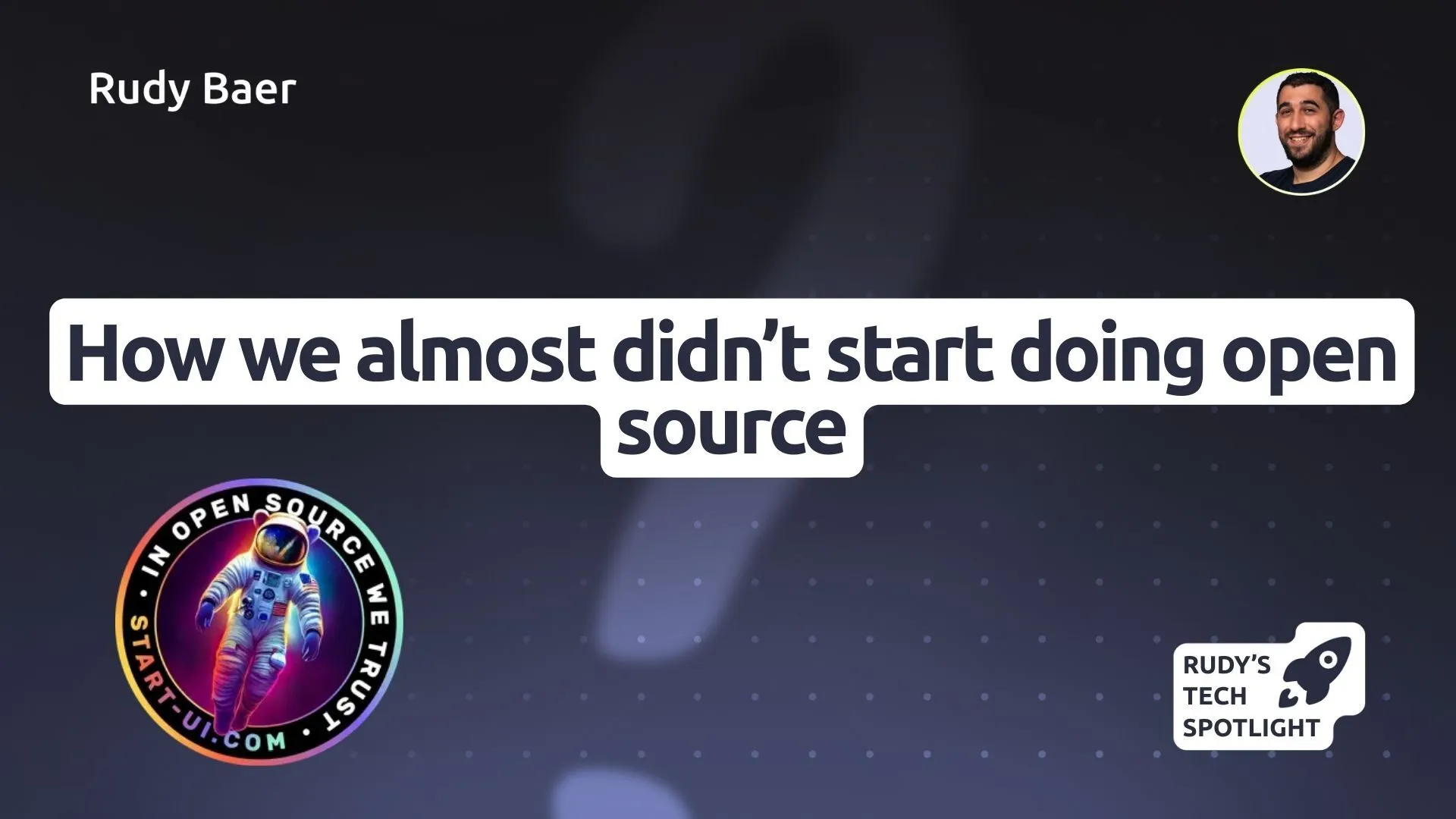How we almost didn't start doing open source

When we started BearStudio, open source was already the rockstar of the development world. Big names like Netflix and Facebook were flexing their open-source muscles, dropping the libraries of the decade and changing how we built the web.
The benefits were clear: open source wasn’t just shaping the tech industry; it was the tech industry. But contributing to it? That felt like something only the tech giants could pull off.
But open source had already given me so much. Tools like JHipster allowed us to kickstart our projects quickly and efficiently, it was one of the core parts of our business. And beyond the technical benefits, open source connected me to a community, enabled knowledge sharing, and even created business opportunities in events like Codeur en Seine.
We had to give back!
The Early Days
Back in 2016, open source was already a big deal among developers, but it hadn’t yet gone mainstream for businesses. Most companies (at least in France) didn’t see it as a strategy or even as something that could bring in business. Every service company, including BearStudio, relies on OSS (Open Source Software) for their business, but few want to contribute because it costs money/time.
At the time, I heard a saying: “If Netflix and Facebook do this much open source, there’s got to be a reason.” And let’s be clear: those companies don’t have a wish to make a better world… It means they identified a business incentive to participate in, and lead, some open-source projects. But at that time, many service companies just wanted to profit from open-source tools to build apps and sell their services—not to contribute to them, because it required more resource allocation to adapt a tool for general use rather than mission-tailored specific features. But I believed that open-source contributions could make a brand better perceived or even attract contributors and talents to your internal tool, just to improve it.
But here’s the thing: I used to believe open source was only for companies whose core activity revolved around software development like Facebook with React. The idea that small companies like ours could make meaningful contributions? That felt way out of reach.
We were heavy users of open source. Tools like JHipster (a project starter kit we loved) were the backbone of our work. And sure, we wanted to contribute back, but the process felt intimidating. How could we efficiently contribute to something like JHipster? We didn’t lack motivation, but we definitely lacked confidence. That felt like sitting at the grown-ups’ table during Christmas dinner.
From Private Code to Public Silence
We always wanted to contribute to open source but never knew how to start. So, like every other company, we focused on internal tools. Tons of them. Little scripts here, dashboards there, and the occasional over-engineered monster tool that we swore would save us hours of work (but mostly just burned hours of dev time).
The thing about internal tools is that they’re easy to build and even easier to forget about. “Open-sourcing them” sounds great on paper, but here’s the brutal truth: releasing them isn’t the hard part. The real challenge is getting someone (anyone) to actually contribute to them.
We even poured serious effort into polishing one tool, convinced it would amaze the world when we released it. Months of work went into it. And then? Nope.
Open source isn’t just about writing code, it’s about making something people want to use and building a community around it. If you’re not ready to commit to documentation, support, and visibility, I hope your tool is REALLY good! After a few years, we still managed to ship Start UI with 42 (!) contributors, but I will tell you that story later.
The Turning Point: JHipster in Bordeaux
Our breakthrough moment came in Bordeaux in September 2020. JHipster was hosting a weeklong conference, and we went there with the team. The goal? To immerse ourselves in the open-source world, learn from the pros, and finally break free from our hesitation because we really wanted to contribute.
It was like a bootcamp but with croissants, because Bordeaux is in France. The sessions were revelations for some, showing that even simple contributions, like a template, could be useful.
I’m really pushy for my team to attend conferences regularly, it’s not only a great way to learn, but also to connect with link-minded people. I’ve written an article a few months ago about tech conferences.
“Your code doesn’t need to be perfect; it just needs to be useful,” was the underlying message.
https://www.jhipster.tech/jhipster-code
Lesson learnt, let’s contribute!
When we returned to Rouen, we were highly motivated. We began writing articles to share our experiences, like Nicolas Torion’s piece on JHipster. But I wanted to go further. I wanted to turn this energy into a habit, into a company culture.
Article in french about what we learnt at the JHipster conference in Bordeaux in 2020
That’s how the idea of the Open Source Week was born. At the end of each year, we closed our doors to clients for a week dedicated to exploring technologies and contributing to open source. The goal? To give everyone the time and space to experiment, learn, and contribute.
Isolated from the outside world, we contribute to open source for an entire week.
Revelation: New Rules for Sustainable Motivation
However, not everything went perfectly. While the Open Source Week led to some great progress, it also revealed certain limitations. I quickly realized that starting an open source project was much easier than maintaining it. Many projects initiated by the team didn’t survive beyond their first few weeks. Sometimes it was due to a lack of time, other times a lack of motivation, open source projects due to their inherent “free contribution” structure are fueled by passion, more than any other kind of software and thus suffer from the “shiny object syndrome”. Every developer knows that because we all have a mountain of unfinished “side projects”.
It took us a few years to find what really worked for us. I had to understand something essential: motivation cannot be imposed. It has to come from within. To avoid wasting resources on abandoned projects, we understood that the process which clicks with our company’s culture is the following: before we allocate resources to a project, an MVP must be created on the employee’s own time. It’s the best way for our team to stay motivated and to “get shit done”. It’s not a rule that I suddenly got but it was more of a gradual progress. I observed that projects following that trajectory were more successful at BearStudio, so it became the rule.
This rule changed everything. It allows us to gauge an employee’s genuine motivation and ensures that the project has a minimum level of viability before we invest time and money. If this condition is met, we gladly allocate resources and do everything we can to support the project.
After the New Rules: Building Meaningful Contributions
With the new rules in place, we began producing more impactful work. One of the first successes was Formiz, a tool started by Ivan Dalmet on his own time. Once the MVP was ready, we integrated it into BearStudio’s repository, allowing the team to contribute and grow the project into a valuable resource for the community.
At the same time, we launched StartUI, a starter kit for web applications built on open source technologies with almost 1500 stars on GitHub today. Its success inspired Nicolas Torion to create a mobile version using React Native, which we later integrated into the main project. We even have a Figma version to keep sure that what our designers decide to design is very easily doable by the front-end team. A proof that open source is not only for devs with long white beards, but for everyone involved in the creation process.
These projects, and the lessons we learned from them, will be explored in detail in the next article.
Share Your Open Source Journey
Our journey into open source has been full of challenges, revelations, and growth. From hesitant beginnings to meaningful contributions like Formiz and StartUI, we’ve learned that open source is not just about code… It’s about community, processes and motivation. It works very differently depending on your company needs and culture, there is no single methodology or path but it’s rather a journey where the challenges will vary for any team.
But this is just our story. What about yours? Whether you’re just starting out or have been contributing for years, we’d love to hear about your experiences, challenges, and successes in open source. Let’s keep the conversation going, share your story with us!

Rudy Baer
August 27, 2025